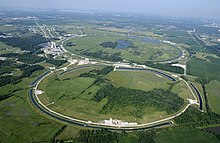 The Tevatron (background) and Main Injector rings | |
| General properties | |
|---|---|
| Accelerator type | synchrotron |
| Beam type | proton, antiproton |
| Target type | collider |
| Beam properties | |
| Maximum energy | 1 TeV |
| Maximum luminosity | 4×1032/(cm2⋅s) |
| Physical properties | |
| Circumference | 6.28 kilometres (6,280 m) |
| Location | Batavia, Illinois |
| Institution | Fermilab |
| Dates of operation | 1983–2011 |
| Beyond the Standard Model |
|---|
 |
| Standard Model |
The Tevatron was a circular particle accelerator (active until 2011) in the United States, at the Fermi National Accelerator Laboratory (called Fermilab), east of Batavia, Illinois, and was the highest energy particle collider until the Large Hadron Collider (LHC) of the European Organization for Nuclear Research (CERN) was built near Geneva, Switzerland. The Tevatron was a synchrotron that accelerated protons and antiprotons in a 6.28 km (3.90 mi) circumference ring to energies of up to 1 TeV, hence its name.[1][2] The Tevatron was completed in 1983 at a cost of $120 million and significant upgrade investments were made during its active years of 1983–2011.
The main achievement of the Tevatron was the discovery in 1995 of the top quark—the last fundamental fermion predicted by the Standard Model of particle physics. On July 2, 2012, scientists of the CDF and DØ collider experiment teams at Fermilab announced the findings from the analysis of around 500 trillion collisions produced from the Tevatron collider since 2001, and found that the existence of the suspected Higgs boson was highly likely with a confidence of 99.8%,[3] later improved to over 99.9%.[4]
The Tevatron ceased operations on 30 September 2011, due to budget cuts[5] and because of the completion of the LHC, which began operations in early 2010 and is far more powerful (planned energies were two 7 TeV beams at the LHC compared to 1 TeV at the Tevatron). The main ring of the Tevatron will probably be reused in future experiments, and its components may be transferred to other particle accelerators.[6]
- ^ "Accelerator History—Main Ring". Fermilab History and Archives Project. Archived from the original on 9 May 2012. Retrieved 7 October 2012.
- ^
R. R. Wilson (1978). "The Tevatron". Fermilab. FERMILAB-TM-0763.
{{cite journal}}: Cite journal requires|journal=(help) - ^ Cite error: The named reference
FNAL Higgs boson resultswas invoked but never defined (see the help page). - ^ "Tevatron experiments observe evidence for Higgs-like particle". CERN. 23 August 2012. Retrieved 21 April 2021.
- ^ Mark Alpert (29 September 2011). "Future of Top U.S. Particle Physics Lab in Jeopardy". Scientific American. Retrieved 7 October 2012.
- ^ Wisniewski, Rhianna (2012-02-01). "The Tevatron's proud legacy". Symmetry Magazine. Fermilab/SLAC.